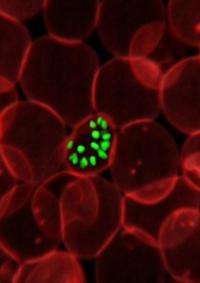Scientists release data on potential new treatment targets for malaria

An international team led by St. Jude Children's Research Hospital investigators today released data detailing the effectiveness of nearly 310,000 chemicals against a malaria parasite that remains one of the world's leading killers of young children.
The research, which appears in the May 20 edition of the scientific journal Nature, identified more than 1,100 new compounds with confirmed activity against the malaria parasite. Of those, 172 were studied in detail, leading to identification of almost two dozen families of molecules investigators consider possible candidates for drug development. St. Jude researchers already used one of the molecules to stop the parasite's growth in mice.
The six-year malaria project was launched by R. Kiplin Guy, Ph.D., St. Jude Department of Chemical Biology and Therapeutics chair, in an effort to revive malaria drug development. Guy is senior author of the study. W. Armand Guiguemde, Ph.D., a postdoctoral fellow in Guy's laboratory, is the first author.
"Malaria causes roughly 8 percent of childhood deaths worldwide and remains among the greatest threats to children in the developing world," Guy said. "At St. Jude, we focus on diseases that kill children, but lack good treatments. That is what drove us to start this work."
"These are the same tools and techniques that we are now using to find new targets and drugs to treat childhood cancer. This work illustrates their enormous power for drug discovery," said Dr. William Evans, St. Jude director and chief executive officer.
The effort has grown into a consortium that includes investigators at nine institutions and foundations in the U.S., Australia and Europe. Collaborators are taking cooperation a step further and launching a public database to share the results of their research and the underlying data.
"We've provided a toolbox to the global community and given them a lot of the early results from working with the tools so they won't have to repeat the work," Guy said. "This new information doubles the number of chemical structures available for anti-malarial drug development."
The database includes the chemical structure and activity profile of each of the 309,474 molecules in the St. Jude library of drugs, natural compounds and other chemicals. There is additional information about the 172 compounds that were more comprehensively evaluated. The compounds are all commercially available. Researchers interested in accessing the database can visit www.stjuderesearch.org/guy/data/malaria.
In recent years, malaria drug development has focused on creating medications against specific targets or on improving existing medications. The approach focused on a handful of chemical targets, and results have been disappointing.
For this study, investigators used a different strategy and surveyed the hospital's library of compounds looking for those effective against the entire malaria parasite. Scientists tested the chemicals against the Plasmodium falciparum, the deadliest of the malaria parasites. The work led St. Jude researchers to three families of molecules, including two believed to act against new targets. Investigators hope to have a new drug in the clinic within a decade.















